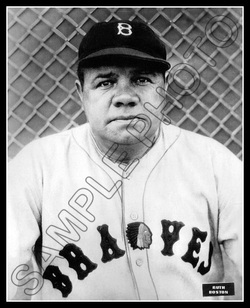
The reason the 1935 Braves season is even an issue is the fact that they finished 78-73 just a year earlier. For the exception of Ruth and Maranville, the team was pretty much the same from 1934-1935. Offensively, the team was led by star CF Wally Berger. 1934 and 1935 were Berger's best offensive seasons, hitting .298, 34, 121 in 1934 and .295, 34, 130 in 1935. Berger did get a little more protection in 1934 as 3B Pinky Whitney hit .259, 12, 79 and LF Hal Lee hit .292, 8, 79 but slipped to .273, 4, 60 and .303, 0, 39, respectively, in 1935.
Perhaps if the team protected Berger a little better and Ruth and Maranville contributed a little more, the team could have finished with a better record. However, there was no excuse for the pitching staff to perform as poorly as they did. Using essentially the same pitchers the season before, it was a completely different result and one that was the sole reason the team finished the 1935 season so poorly.
Among the team's top seven pitchers, all whom pitched for the Braves in 1934 and 1935, the team had a pitcher win 16 games and 2 win 17 in 1934, with one pitcher losing only 14 games. The 1935 version saw only one pitcher win 11 games and single pitchers losing 15, 18, 19 and 25 games. I find it amazing that there would such a stark contrast when dealing with specifically the same pitchers. Usually you see teams struggle like the pre-1969 New York Mets and pre-1991 Atlanta Braves and good pitchers finished with poor records because of bad teams. Afterwards, the teams get better and the pitchers become stars and we quickly forget about the poor records the pitchers had the year(s) before. I feel confident saying this had to be the primary example of a year with good pitching returning its staff to be so poor the next season.
Fred Frankhouse was the Braves best SP in 1934, finishing 17-9, 3.20 in 37 games, 31 starts. He was by leaps and bounds the best pitcher on the 1935 team as well, finishing at 11-15, 4.76 in 40 games, 29 starts. Huck Betts was 17-10, 4.06 in 40 games, 27 starts in 1934, only to go 2-9, 5.47, 44, 19 a year later. Ed Brandt was 16-14, 3.53, 40, 28 in 1934 and 5-19, 5.00, 29, 25 in 1935. The worst was Ben Cantwell, who was 5-11, 4.33, 27, 19 in 1934 only to go 4-25, 4.61, 39, 24 in 1935. Cantwell was the last pitcher to lose as many as 25 games in a season. Flint Rhem was 8-8, 3.60, 25, 20 in 1934 and 0-5, 5.36, 10, 6 in 1935. Bob Brown was 1-3, 5.71, 16, 8 in 1934 and 1-8, 6.37, 15, 10 in 1935. Their top relief pitcher was Bob Smith, who went 6-9, 6 saves, 4.66, 39, 5 in 1934 and 8-18, 5 saves, 3.94, 46, 20 in 1935. You can make a case that Smith pitched to a lower ERA and made more starts and simply had some bad luck to have that many losses. Smith's 5 1935 saves were the only ones recorded that season by Braves pitching. While Smith's 6 saves led the 1934 team, Cantwell and Brandt had 5, Betts 3 and Frankhouse had 1 for a total of 20 for the team. The seven pitchers combined to go 70-64 with 20 saves in total of 138 starts in 1934. The following season, the same seven pitchers combined to go 31-99, 5 saves in 133 starts. A remarkable 37 game digression with all seven pitchers suffering through lower winning percentages.
In 1936, the seven pitchers just about went their own ways, with just Cantwell (9-9, 3.04) and Smith (6-7, 8 saves, 3.77) being major parts of the 1936 Boston Bees staff. Brown pitched in the final two games of his career, losing them both with a 5.40 ERA. Betts never pitched again after 1935 and Frankhouse and Brandt were both dealt separately to the Brooklyn Dodgers before the 1936 season. For the record, the Bees improved to 71-83 in the 1936 season. Ironically, the man who oversaw the 1934-1936 Braves/ Bees was eventual Hall of Famer Bill McKechnie, who previously had led the 1925 Pittsburgh Pirates to a World Series Championship and the 1928 St Louis Cardinals to the NL Pennant and later led the Cincinnati Reds to the 1939 NL Pennant and the 1940 World Series. The Pirates spring training field in Bradenton, Fl is named McKechnie Field in his honor.

 RSS Feed
RSS Feed
